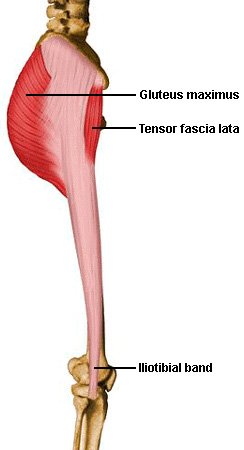
Iliotibial Band Syndrome
Synopsis
Iliotibial band syndrome is due to inflammation of the iliotibial band, a thick band of fibrous tissue that runs down the outside of the leg. The iliotibial band begins at the hip and extends to the outer side of the shin bone (tibia) just below the knee joint. The band functions in coordination with several of the thigh muscles to provide stability to the outside of the knee joint.

Iliotibial band syndrome (ITBS) occurs when there is irritation to this band of fibrous tissue. The irritation usually occurs over the outside of the knee joint, at the lateral epicondyle--the end of the femur (thigh) bone. The iliotibial band crosses bone and muscle at this point; between these structures is a bursa which should facilitate a smooth gliding motion. However, when inflamed, the iliotibial band does not glide easily, and pain associated with movement is the result. As stated previously, the function of the iliotibial band is both to provide stability to the knee and to assist in flexion of the knee joint. When irritated, movement of the knee joint becomes painful. Usually the pain worsens with continued movement, and resolves with rest.
Diagnosis and Treatment
People who suddenly increase their level of activity, such as runners who increase their mileage, often develop iliotibial band syndrome. Others who are prone to ITBS include individuals with mechanical problems of their gait such as people who over pronate, have leg length discrepancies, or are bow-legged.
Treatment of ITBS begins with proper footwear, icing the area of pain, and a
stretching routine. Limiting excessive training, resting for a period of time,
and incorporating low-impact cross-training activities may also help, your
doctor may also recommend a custom foot orthotic as well.
Anti-inflammatory medications may be prescribed by your doctor to help decrease
the inflammatory response around the area of irritation. If these treatments do
not solve the problem, working with a physical therapist to develop a more
focused stretching and strengthening routine may help. Cortisone injection into
the area of inflammation may also be attempted, usually after these other
treatments fail. If all else fails, surgery is an option, but only in very rare
circumstances.